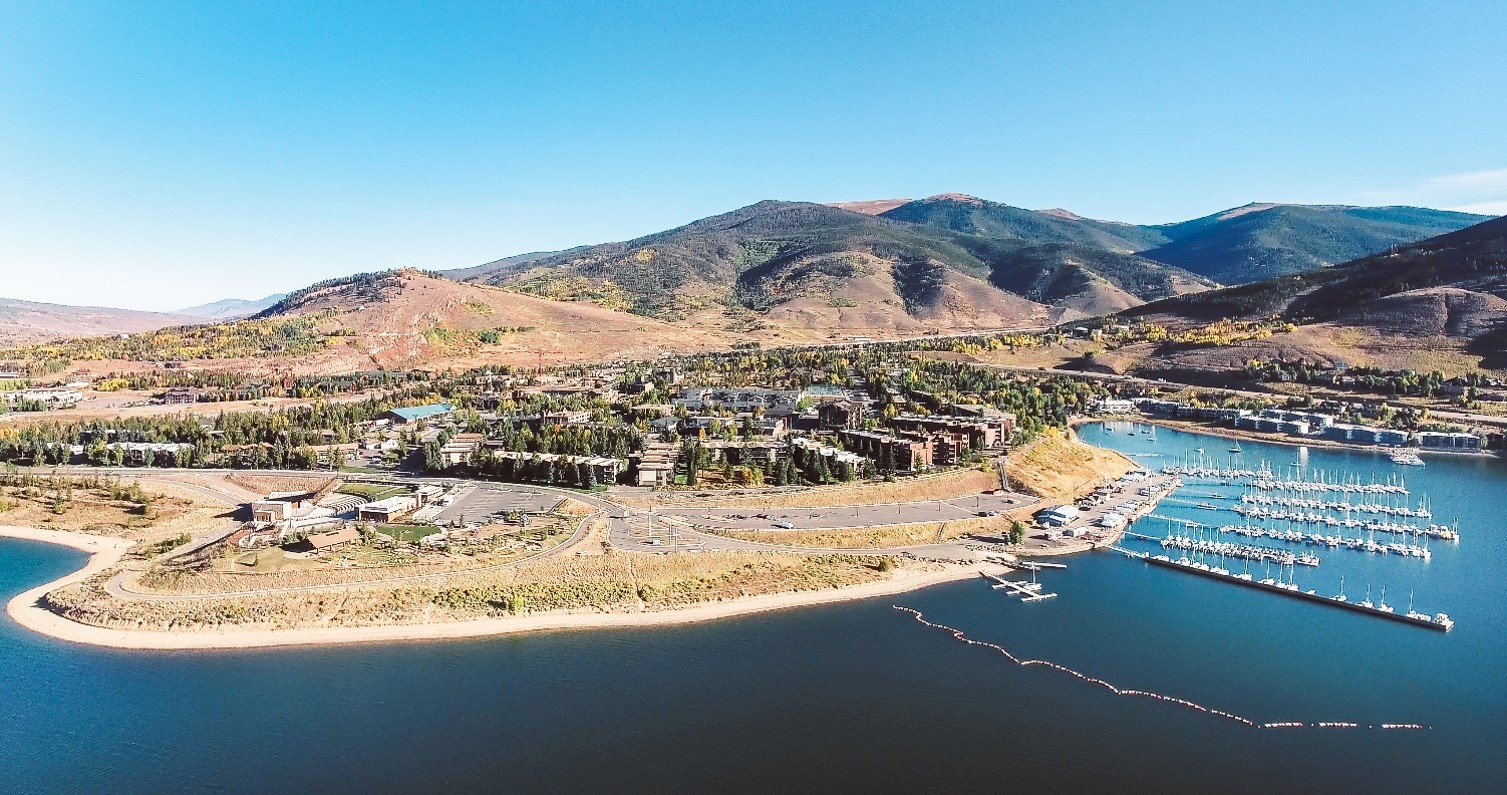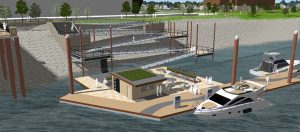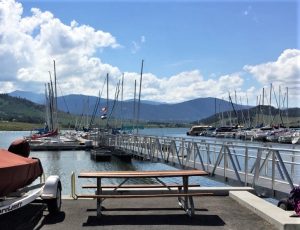
Equitable Marina Design – ADA Standards for Safe Waterfront Use
Published on March 23, 2022There is limited scope requiring marinas to apply Americans with Disabilities Act (ADA) guidelines to over-the-water structures. But standards do exist, and marinas taking a “wild west” approach to compliance are potentially setting themselves up for costly legal disputes — and missed opportunities to attract a new and sustainable boating clientele.
Since the ADA was signed into law on July 26, 1990, it has been protecting and providing equal access for individuals with disabilities in most all arenas of public life: jobs, schools, transportation networks, rights of way, and lands open to public use. Revisions to the act in 2010 added recreational facilities to the scope of compliance per Americans with Disabilities Act Accessibility Guidelines (ADAAG) for “Recreational Boating Facilities,” Sections 235 and 1003. Ever since, communities have been auditing and upgrading park and recreational amenities to meet or exceed standards.
Yet many components of marina and waterfront facilities are exempt from ADA conformance due to their location over a moving body of water. The rationale is that water levels can fluctuate greatly, and other dynamic environmental factors such as wind and waves can be just too unpredictable in nature to develop design standards around. The truth is, there are many safe, accessible, and sustainable solutions at hand. Marina owners and operators just need to be willing to correct what is deficient and invest in facilities that are welcoming to people of all ages and abilities: those with physical challenges, aging boat owners, guests with strollers or mobility assist devices, and those who are young or injured.
Accessible Inner Harbor Structures
Piers, floating docks, slips, and gangways are the building blocks of small craft harbors and marinas. How they function as independent components and how they serve as safe water-to-land connectors is critical. To create welcome, inclusive waterfront facilities, marinas should complete a thorough audit or assessment of existing infrastructure and ascertain whether it meets ADA guidelines for safe use. This is required for any publicly owned or operated marina under Title II. Commercially owned and operated facilities are required to address accessibility under Title III.
Gangways
An excellent place to begin is by evaluating gangway length and slope relative to historic high and low water level data. While water levels are reaching new and more extreme fluctuations under the influence of a changing global climate, engineers can at least pinpoint the lowest possible water level mark (lake or river bottom) and then design gangways in response to that data — with the goal of maintaining a mild, manageable slope from land to water. ADA guidelines define this as a 1:12 maximum slope or at least an 80-foot gangway length. Common sense says that an 8% slope should easily support the safe passage of people under most conditions, while a 20% slope should be called a slide! In our work, we strive for the 8% mark and design for any marina gangways to not surpass it, even at extreme dry or low-water conditions.
There are other options for gangway design to maintain a safe slope. Multiple, connected “accordion” or folding gangways allow marinas to build “stoppers” into the design. Here, steel rings can be bolted onto the support piles to “catch” sections of gangway as they descend, resulting in the gangway section stopping at that predetermined 8% grade mark. Similarly, piles themselves can be constructed to serve as stoppers, arranged in groups of four, let’s say, with a steel platform on top that stops the gangway when it reaches the desired level. In domino-like fashion, each individual section of gangway descends until it stops at 8% and is better able to accommodate varying water levels without a substantial increase in overall grade.
Gangway materials and features can be optimized as well. The safest options are gangways that have grates, allowing precipitation to pass through rather than accumulate on the surface and create slippery conditions. Non-skid options are available through manufacturers as well, ranging from knurled grid-like textures to special slip-resistant finishing treatments. Marinas should be sure to maintain clear, unobstructed access throughout all gangway corridors, install adequate handrails and transition plates, and incorporate lighting to keep passageways properly illuminated at night or in low-visibility conditions.
Finger Piers and Boat Slips
Marinas of all sizes are required to provide at least one accessible boat slip, with the number of required accessible slips increasing as the total number of slips at the marina increases. Meaning: the larger the marina, the more that are required. (ADAAG Section 235.2 defines the number of accessible slips required.) Marinas would also be wise to provide, at minimum, one accessible slip with a service chair lift or transfer device/crane to assist guests in getting on or off their vessels. Whether for those with disabilities or an aging boating population — this investment will not go unappreciated.

All marina finger piers should ideally be wider than standard practice as well. A good rule of thumb is that for every 10-foot increase in boat slip length, the width of the finger pier should increase by one foot. For instance, a 30-foot boat slip would need a 3-foot-wide finger, a 40-foot slip — a 4-foot finger, etc. Access routes must be wide enough for a wheelchair to turn around, and edge protection measures are encouraged to keep guests safely on the dock.
Compliant Land-based Support Facilities
Throughout upland marina facilities, ADA compliance is a necessity. Public facilities, restrooms, ship stores, restaurants and bars, parking areas, multimodal paths, and recreational spaces are all required to comply with ADA regulations. All elements within and leading to structures should follow the United States Access Board Accessibility Guidelines for Buildings and Facilities. Different rules apply to access roads and any marina entrance or transit route that enters the public right of way. In this case, guidelines are set forth by the United States Access Board Public Right-of-Way Accessibility Guidelines (PROWAG). The rules are detailed, so marina managers should be prepared to make the investments needed to meet compliance.
Some of the most common offenders of non-compliance on marina grounds are steep paths, unsafe transition areas, and steps. Multimodal paths, waterfront promenades, sidewalks or ramps to buildings and land-based amenities — these paths of travel are frequently too steep for safe use. Cross slopes, running slopes, and total vertical rise should all be evaluated so as not to surpass ADA-compliant grades. Transitions areas from paths to static marina infrastructure are also frequently dangerous or inaccessible. Transitions plates at the top and bottom of gangways, for example, are often at excessive slopes. While handrails in these areas are not required, they are good marina practice. Steps at the tops of gangways are an absolute “no-no” and directly impede the ability of visitors with mobility challenges to access the water. Steps in this location are unsafe and frustrating for other boat owners as well — a hazard to those wishing to transport goods from land to vessels and back via dock carts.
ADA Standards vs. the Court of Law
Marina injuries happen. Not only to those with mobility challenges, but to anyone visiting marina properties that are haphazardly designed, unkempt, or in defiance of ADA standards. And while the scope of ADA standards is limited when it comes to over-the-water elements, the guidelines do take legal precedence and will hold up accordingly if challenged.
The decision to modernize or re-engineer marina property to meet compliance guidelines can be difficult. And it’s no secret that every inch of water and waterfront property is valuable, viable real estate. To rationalize spending the money, marina managers should work with trained professionals to select renovations that satisfy both form and function. Here, civil and structural engineers can evaluate existing infrastructure to assess ADA compliance and make recommendations for upgrades to the marina “hardscape.” To soften the aesthetic, a landscape architect or landscape designer can help fuse the hardscape with the “softscape,” pulling in an artistic eye to make the space more inclusive, interactive, and appealing. These additions might include native plantings, suggestions for site flow, land-water connections, community engagement ideas, and solutions for site drainage and stormwater conveyance. The point being, there are a multitude of ways to meet compliance while also enriching the marina atmosphere.

So, the question becomes: should marina owners make the appropriate investments to keep their facilities safe and inclusive? The unequivocal answer is yes. Deciding otherwise is only tempting fate and inviting lawsuits — ones that could be catastrophic for a marina’s bottom line as well as its public image.
The More the Merrier
Some marina operators will reluctantly acquiesce to the suggested upgrades, and others will continue to feign ignorance. Many, we hope, will embrace the move into modern marina design. Choosing to make the right adaptations benefits all of us, in a multitude of ways. And the return on investment is more than just money saved from accidents and lawsuits that never come to fruition. The return also comes in the form of community goodwill, positive public relations, and the attraction of a new, more diverse community of boat owners and guests. In today’s world, mere ADA compliance should not be the goal. The goal should be to provide fair access and equal opportunity for every individual to share in the incomparable joy of boating.
Dan Williams, PLA, ASLA, AHLP is senior landscape architect at MSA. He can be reached at dwilliams@msa-ps.com.
| Categories | |
| Tags |





